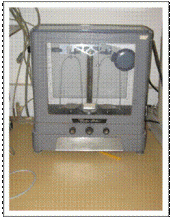The chainweight balance allowed more rapid determination of small weights by substituting a precision chain weight for the small (<100 mg) weights of the traditional balance. Thus, once the operator came to within 100 mg of the desired weight, he/she would no longer need to arrest the beam, open the balance case, add additional weights, close the case, release the beam and observe its swing, etc. greatly speeding the determination of exact weights. This instrument also has a notched beam allowing up to 1 gm of additional mass (for a total of 1.1 gm) to be added without opening the case.
The chainweight balance was patented by Christian Becker in 1915.1 Christian Becker introduced aluminum cased balances such as the current model in 1950, replacing the older mahogany cased versions.
This is Christian Becker's top-of-the-line Chainomatic analytical balance. The aluminum case is gray crinkle finished with nickel plated (now corroded on the outside) trim. There are glass panels on the front and top, with a translucent opal glass panel on the back. The plate is black glass setting on a cast aluminum base.l. The case is 20"h x 18 1/4"w x 9"d. There is a drawer in the base. The balance has stainless steel pans on polished brass, 3-piece, hangers. The column is enclosed in a polished brass sheath. This balance was acquired in 1952 for $462.48.

